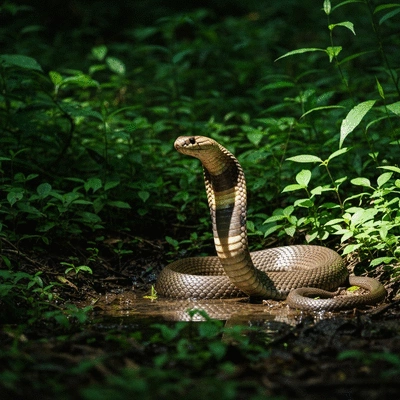What if the key to understanding the fascination with wildlife lies in our emotional responses? King cobras, with their striking beauty and fierce reputation, evoke a mix of admiration and fear, captivating viewers around the globe. Exploring this allure can enhance our appreciation for these majestic creatures and their role in the ecosystem.
What You Will Learn
- The fear factor associated with king cobras creates an adrenaline rush that attracts viewers.
- King cobras exhibit unique behaviors, including defensive postures and calm encounters, which highlight their complexity.
- Misconceptions about king cobras, such as the belief that they chase humans, often misrepresent their true nature.
- YouTube plays a significant role in popularizing king cobra content, allowing global audiences to engage with wildlife narratives.
King Cobra's Captivating Traits and Behavior
The King Cobra is a creature of immense fascination, captivating audiences with its unique biological attributes and intriguing behaviors. Below is a visual summary of what makes these serpents so captivating.
What Makes King Cobra Videos Captivating?
Fear Factor
Inherent danger creates an adrenaline rush for viewers.
Admiration for Nature
Awe-inspiring beauty and grace spark a sense of wonder.
Disbelief
Unbelievable encounters prompt viewers to share the experience.
Unique Traits
- Length: Up to 18 feet.
- Venom Potency: Lethal dose in a single bite.
- Habitat: Dense forests, near water (Southeast Asia).
Key Behaviors
- Defensive: Hoods raised, hiss when threatened.
- Calm: Often prefer to retreat than engage.
- Mating: Males engage in combat dances.
Diet & Hunting
- Prey: Primarily other snakes, lizards, small mammals.
- Method: Ambush tactics, striking with precision.
- Digestion: Can eat large prey, takes time.
Myth vs. Fact
- Myth: Chase humans.
Fact: Prefer to avoid. - Myth: All snakes venomous.
Fact: Only a small percentage.
Understanding the Fascination with King Cobras in Viral Videos
The allure of king cobras in viral videos is undeniable! These majestic creatures evoke strong emotional responses, ranging from fear and admiration to sheer disbelief. It's fascinating to see how a cold-blooded reptile can captivate millions, triggering both excitement and caution. People are naturally drawn to the unexpected, and king cobras, with their striking appearance and fierce reputation, deliver just that!
What’s more, these videos often showcase the unique bond between humans and wildlife. Each encounter offers a glimpse into the snake's behavior, making us reflect on our own emotions and reactions. It's this complex interplay that fuels the fascination with king cobra content.

What Makes King Cobra Videos So Captivating?
Let’s break down the key elements that make king cobra videos so enthralling:
- Fear Factor: The inherent danger associated with king cobras adds an adrenaline rush that viewers can hardly resist.
- Admiration for Nature: Viewers often find themselves in awe of the beauty and grace of these snakes, which sparks a sense of wonder.
- Disbelief: Many people can't believe the encounters captured on camera, which makes them want to share the experience with others.
These elements combined create a compelling narrative that keeps viewers coming back for more. Each video is an invitation to experience the wild up close, often leaving us with a mix of emotions.
Recent Viral King Cobra Encounters
Several videos have taken the internet by storm, showcasing incredible interactions with king cobras. For instance, one particularly notable video features a wildlife expert gently handling a king cobra during a rescue operation. The expert's calm demeanor contrasts sharply with the snake's natural agility, creating a dramatic moment that has been shared widely.
Another viral hit shows a king cobra defending its territory against a perceived threat, reminding us of the raw instincts these creatures possess. As I watched these clips, I couldn’t help but feel a mixture of respect and concern for both the animals and the people involved in these encounters. Each video reflects the delicate balance between human curiosity and the need for caution.
The Role of YouTube in Popularizing King Cobra Content
YouTube has become a powerhouse for wildlife content, especially when it comes to king cobras. Its vast reach allows viewers worldwide to engage with fascinating stories and visuals that wouldn’t otherwise be accessible. For a deeper understanding of wildlife in their natural environment, infrared camera footage, like that mentioned in a report by The Star, provides rare glimpses into the behavior of these magnificent creatures.
Pro Tip
When viewing king cobra videos, pay attention to the subtle behaviors that indicate their mood. Understanding these signs can enhance your appreciation for these magnificent creatures and promote safer interactions in real-life encounters.
Insights into King Cobra Behavior and Biology
Understanding the king cobra goes beyond its fearsome reputation. These magnificent serpents exhibit a range of unique traits that not only fascinate wildlife enthusiasts but also contribute to their role in the ecosystem. From their impressive length, reaching up to 18 feet, to the potent venom that can kill an elephant, the king cobra is truly a remarkable creature. Let’s dive into what makes them so intriguing!
Unique Traits of the King Cobra
The king cobra is the longest venomous snake in the world, but it's not just their size that captivates. Their striking appearance includes a hood that can expand, which they display when threatened. The venom of a king cobra is one of the most powerful, containing neurotoxins that affect the victim's nervous system. However, their habitat is equally important; they thrive in forests and wetlands across Southeast Asia. Learning about their specific regions, such as Borneo, can provide further context, as highlighted by The King Cobra organization. Here are some key attributes:
- Length: Can grow up to 18 feet.
- Venom Potency: Capable of delivering a lethal dose with just a single bite.
- Habitat: Prefers dense forests and is often found near water.
These traits not only make king cobras fascinating to watch but also crucial to their ecosystems. Their hunting skills and behavior have evolved to adapt to their environments effectively.

Understanding the Behavior of King Cobras
When it comes to king cobra behavior, it's essential to recognize the difference between aggression and calmness. While they may strike when threatened, they tend to be more reclusive than their reputation suggests. Observing them in the wild, you can see their calm reactions during moments of non-threat. This duality makes them intriguing and often misunderstood. For example, learning about how herpetologists study specimens, such as the Luzon King Cobra, as shown in WTTW's video, offers insight into their behavior and anatomy. Here are some behaviors to consider:
- Defensive Posture: They raise their hoods and may hiss when feeling threatened.
- Calm Encounters: Often, they prefer to retreat rather than engage.
- Mating Rituals: Males engage in combat dances to attract females.
By understanding these behaviors, we can appreciate the complexity of king cobras and how they interact with their environment and humans.
Animal Facts and Myths About King Cobras
There are many myths surrounding king cobras, often fueled by their portrayal in media and popular culture. Let's debunk some common misconceptions while sharing fascinating facts about these incredible reptiles:
- Myth: King cobras chase humans.
- Fact: They prefer to avoid humans and will usually retreat.
- Myth: All snakes are venomous.
- Fact: Only a small percentage of snakes, including the king cobra, are venomous.
Knowing these facts not only enriches our understanding but also fosters a sense of respect for these magnificent creatures. It's vital that we separate fact from fiction to appreciate their role in our ecosystems truly.
The King Cobra Diet and Hunting Techniques
The diet of a king cobra predominantly consists of other snakes, but they are also known to consume lizards and small mammals. Their hunting techniques are quite remarkable, showcasing their efficiency as predators. Here are some key aspects of their diet and hunting behavior:
- Prey: Primarily other snakes, including venomous ones.
- Hunting Method: They employ ambush tactics, often striking with precision.
- Digestive Process: They can eat large prey and take time to digest.
Understanding the king cobra's diet and hunting skills highlights their critical role in maintaining the balance of their ecosystem. As you observe these remarkable hunters, consider the intricate relationships they have with their prey and environment.
Frequently Asked Questions About King Cobras
Here are some common questions about king cobras and their fascinating characteristics:
- Q: Why are king cobra videos so captivating?
A: King cobra videos are captivating due to a combination of factors: the inherent fear factor, which provides an adrenaline rush; the admiration for their natural beauty and grace; and the sheer disbelief at some of the encounters, prompting viewers to share. - Q: What is the primary diet of a king cobra?
A: King cobras primarily prey on other snakes, including venomous ones. They also consume lizards and small mammals. - Q: Do king cobras chase humans?
A: No, this is a myth. King cobras prefer to avoid humans and will usually retreat when encountered. They are generally reclusive. - Q: How long can a king cobra grow?
A: King cobras are the longest venomous snakes in the world, capable of growing up to 18 feet in length. - Q: What role does YouTube play in popularizing king cobra content?
A: YouTube plays a significant role by providing a platform for wildlife content to reach a global audience, making fascinating stories and visuals of king cobras accessible to millions worldwide. - Q: Where do king cobras typically live?
A: King cobras thrive in dense forests and are often found near water sources across Southeast Asia.
Recap of Key Points
Here is a quick recap of the important points discussed in the article:
- Fear Factor: The danger associated with king cobras adds an adrenaline rush, making them captivating for viewers.
- Admiration for Nature: Their beauty and grace evoke awe and wonder, drawing in audiences.
- Unique Traits: King cobras can grow up to 18 feet and possess one of the most potent venoms among snakes.
- Behavior Understanding: They often prefer to retreat when not threatened, highlighting their complexity.
- YouTube's Role: The platform significantly popularizes king cobra content, allowing global access to fascinating wildlife stories.






